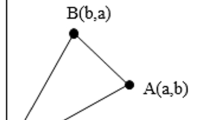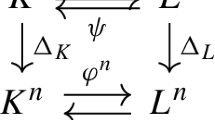Abstract
Tverberg’s theorem says that a set with sufficiently many points in \({\mathbb {R}}^d\) can always be partitioned into m parts so that the \((m-1)\)-simplex is the (nerve) intersection pattern of the convex hulls of the parts. The main results of our paper demonstrate that Tverberg’s theorem is just a special case of a more general situation, where other simplicial complexes must always arise as nerve complexes, as soon as the number of points is large enough. We prove that, given a set with sufficiently many points, all trees and all cycles can also be induced by at least one partition of the point set. We also discuss how some simplicial complexes can never be achieved this way, even for arbitrarily large sets of points.











Similar content being viewed by others
References
Aichholzer, O., Aurenhammer, F., Krasser, H.: Enumerating order types for small point sets with applications. Order 19(3), 265–281 (2002)
Bárány, I., Soberón, P.: Tverberg’s theorem is 50 years old: a survey. Bull. Am. Math. Soc. 55(4), 459–492 (2018)
Björner, A., Las Vergnas, M., Sturmfels, B., White, N., Ziegler, G.M.: Oriented Matroids. Encyclopedia of Mathematics and its Applications, vol. 26. Cambridge University Press, Cambridge (1999)
Carlsson, G., Mémoli, F.: Classifying clustering schemes. Found. Comput. Math. 13(2), 221–252 (2013)
Conlon, D., Fox, J., Sudakov, B.: Hypergraph Ramsey numbers. J. Am. Math. Soc. 23(1), 247–266 (2010)
Cordovil, R., Duchet, P.: Cyclic polytopes and oriented matroids. Eur. J. Comb. 21(1), 49–64 (2000)
Dey, T.K., Mémoli, F., Wang, Y.: Topological analysis of nerves, Reeb spaces, mappers, and multiscale mappers. In: 33rd International Symposium on Computational Geometry (Brisbane 2017). Leibniz Int. Proc. Inform., vol. 77, # 36. Leibniz-Zent. Inform., Wadern (2017)
Eckhoff, J.: Extremal interval graphs. J. Graph Theory 17(1), 117–127 (1993)
Erdös, P., Szekeres, G.: A combinatorial problem in geometry. Compos. Math. 2, 463–470 (1935)
Gan, G., Ma, C., Wu, J.: Data Clustering: Theory, Algorithms, and Applications. ASA-SIAM Series on Statistics and Applied Mathematics. SIAM, Philadelphia (2007)
Graham, R.L., Rothschild, B.L., Spencer, J.H.: Ramsey Theory. Wiley-Interscience Series in Discrete Mathematics and Optimization. Wiley, New York (1990)
Grünbaum, B.: Convex Polytopes. Pure and Applied Mathematics, vol. 16. Interscience Publishers–Wiley, New York (1967)
Jain, A.K.: Data clustering: 50 years beyond K-means. Pattern Recogn. Lett. 31(8), 651–666 (2010)
Lekkerkerker, C.G., Boland, J.Ch.: Representation of a finite graph by a set of intervals on the real line. Fund. Math. 51, 45–64 (1962/63)
Matoušek, J.: Lectures on Discrete Geometry. Graduate Texts in Mathematics, vol. 212. Springer, New York (2002)
Morris, W., Soltan, V.: The Erdős–Szekeres problem. In: Open Problems in Mathematics, pp. 351–375. Springer, Cham (2016)
Perel’man, G.Ya.: Realization of abstract \(k\)-skeletons as \(k\)-skeletons of intersections of convex polyhedra in \({\bf R}^{2k-1}\). In: Proceedings of the Geometric Questions in the Theory of Functions and Sets, pp. 129–131. Kalinin. Gos. Univ., Kalinin (1985). (in Russian)
Perles, M.A., Sigron, M.: Some variations on Tverberg’s theorem. Isr. J. Math. 216(2), 957–972 (2016)
Pór, A.: Universality of vector sequences and universality of Tverberg partitions (2018). arXiv:1805.07197
Reay, J.R.: Several generalizations of Tverberg’s theorem. Isr. J. Math. 34(3), 238–244 (1979)
Richter-Gebert, J., Ziegler, G.M.: Oriented Matroids. In: Handbook of Discrete and Computational Geometry. CRC Press Ser. Discrete Math. Appl., pp. 111–132. CRC, Boca Raton (1997)
Roudneff, J.-P.: New cases of Reay’s conjecture on partitions of points into simplices with \(k\)-dimensional intersection. Eur. J. Comb. 30(8), 1919–1943 (2009)
Sturmfels, B.: Cyclic polytopes and \(d\)-order curves. Geom. Dedic. 24(1), 103–107 (1987)
Suk, A.: On the Erdős–Szekeres convex polygon problem. J. Am. Math. Soc. 30(4), 1047–1053 (2017)
Tancer, M.: \(d\)-Representability of simplicial complexes of fixed dimension. J. Comput. Geom. 2(1), 183–188 (2011)
Tancer, M.: Intersection patterns of convex sets via simplicial complexes: a survey. In: Thirty Essays on Geometric Graph Theory, pp. 521–540. Springer, New York (2013)
Tverberg, H.: A generalization of Radon’s theorem. J. Lond. Math. Soc. 41, 123–128 (1966)
Wegner, G.: Eigenschaften der Nerven homologisch-einfacher Familien im \({\mathbb{R}}^n\). PhD thesis, Georg-August-Universität, Göttingen (1967)
Acknowledgements
We are truly grateful to the three anonymous referees who sent many corrections and improvements. We are also in debt with Florian Frick, Steve Klee, Frédéric Meunier, Luis Montejano, Attila Pór, David Rolnick, and Pablo Soberón, who gave us useful suggestions and encouragement in the very early stages of this project. The research of the first, second, and fourth author were partially supported by NSF Grants DMS-1522158 and DMS-1818969. Déborah Oliveros was supported by PASPA (UNAM) and CONACYT during her sabbatical visit to UC Davis, as well as by Proyecto PAPIIT 107218, 106318 and CONACYT Ciencia Básica 282280. This author would also like to express her appreciation of the UC Davis Mathematics department’s hospitality during her visit.
Author information
Authors and Affiliations
Corresponding author
Additional information
Editor in Charge: János Pach
Publisher's Note
Springer Nature remains neutral with regard to jurisdictional claims in published maps and institutional affiliations.
Appendix A: Proofs of Auxiliary Lemmas
Appendix A: Proofs of Auxiliary Lemmas
We include proofs of some supplementary lemmas mentioned in the introduction.
Proof of Lemma 1.3
Suppose by contradiction that \({{\,\mathrm{Tv}\,}}(K,d)< 2n\). Let \(S \subset {\mathbb {R}}^d\) be a set of points in convex position with \(|S|={{\,\mathrm{Tv}\,}}(K,d)\). By the pigeonhole principle, if we partition S into n disjoint subsets, there must be at least one subset that is a singleton \(\{{\varvec{x}}\}\). Since K is connected, the node corresponding to the singleton \(\{{\varvec{x}}\}\) is connected, by an edge, to at least one other node, implying that \(\{{\varvec{x}}\}\) is in the convex hull of another subset. However, this is a contradiction as the points are in convex position. \(\square \)
Proof of Lemma 1.6
To show that \(\mathcal {N}^1(\mathcal {P}) = \mathcal {N}^1(\sigma ({\mathcal {P})})\) it suffices to show that \({{\,\mathrm{conv}\,}}(P_{i_1})\cap {{\,\mathrm{conv}\,}}(P_{i_2}) \ne \emptyset \) if and only if \({{\,\mathrm{conv}\,}}(\sigma (P_{i_1}))\cap {{\,\mathrm{conv}\,}}(\sigma (P_{i_2})) \ne \emptyset \) for all \(i_1, i_2 \in [n]\). Suppose \({{\,\mathrm{conv}\,}}(P_{i_1})\cap {{\,\mathrm{conv}\,}}(P_{i_2}) \ne \emptyset \). Then they contain respectively \(P_{i_1}'\) and \(P_{i_2}'\), which are an inclusion minimal Radon partition of \(S_1\). Since \(\sigma \) is an order-preserving bijection, \(\sigma \) is an isomorphism between oriented matroids (see, for instance, [21]) determined by \(S_1\) and \(S_2\). The minimal Radon partitions in \(S_1\) correspond to the circuits of the oriented matroids and therefore are preserved under \(\sigma \). Thus \({{\,\mathrm{conv}\,}}(\sigma (P_{i_1}'))\cap {{\,\mathrm{conv}\,}}(\sigma (P_{i_2}')) \ne \emptyset \). The reverse implication is shown by the reasoning applied to \(\sigma ^{-1}\). \(\square \)
As we mentioned in the introduction, the graph K in Fig. 12 is 2-partition induced (in particular, by the partitioned point set in Fig. 13), but not 2-Tverberg, as implied by the following lemma:
Lemma A.1
Suppose S is any set of points in convex position in \({\mathbb {R}}^2\). Then the graph K in Fig. 12 is not partition induced on S.

Proof
We note that since K is a triangle free graph, it suffices to show that it is not the intersection graph of any partition of points in convex position. We argue by contradiction. Suppose that there is a set of points in convex position partitioned so that the graph above is their intersection graph. By Lemma 1.6 we may assume the points are arranged on the boundary of a disc \(\mathcal {D}\). Call the convex hull of the points corresponding to each node i by region i. In the rest of the proof of Lemma A.1, we will rely on the following.
Claim
Consider the independent set of nodes \(\{A,B,C\}\) in Fig. 12. Up to exchanging their labels (note that the graph is symmetric about A, B, C), there are two possible arrangements of the regions A, B, and C, pictured in Fig. 5.
Proof of the claim
The region \(\mathcal {M}-B\) has two connected components. If regions A and C lie in different connected components of \(\mathcal {M}-B\), then regions A, B, and C must be arranged as in Fig. 5. Otherwise, A and C lie in the same connected component, say \(\mathcal {N}\), of \(\mathcal {M}-B\). If we walk clockwise around the boundary of \(\mathcal {N}\), we can only alternate twice between being in regions A and C, reducing to the two possibilities shown. \(\square \)
By the claim, we see that A, B, and C must be arranged (up to symmetry) as in one of the two cases pictured above. If they are arranged as in Fig. 5, note that regions E and F both intersect regions A, B, and C. In that case it is easy to see that regions E and F must intersect, which is a contradiction.
If the regions are arranged as in Fig. 5, consider those regions D, F, G, and H. Note that the region D intersects A, B, C. Also, region F is disjoint from all the regions B through H, while is intersecting A. Similarly, region G is disjoint from all the regions A through H except B. Also region H is disjoint from all the regions A through H except C. Considering the two cases: F, G, H lie in the same connected component of \(\mathcal {M} - D\), or F, G, H lie in different connected components of \(\mathcal {M}-D\), it is easy to see that, in both cases, F, G, and H must be arranged as A, B, and C are in Fig. 5. Then I, J are disjoint but both intersect F, G, and H, which is a contradiction by the argument above. Thus K cannot be the nerve of a set of points in convex position. \(\square \)
Rights and permissions
About this article
Cite this article
De Loera, J.A., Hogan, T.A., Oliveros, D. et al. Tverberg-Type Theorems with Altered Intersection Patterns (Nerves). Discrete Comput Geom 65, 916–937 (2021). https://doi.org/10.1007/s00454-020-00241-9
Received:
Revised:
Accepted:
Published:
Issue Date:
DOI: https://doi.org/10.1007/s00454-020-00241-9
Keywords
- Tverberg’s theorem
- Nerve complexes
- Geometric Ramsey theory
- Combinatorial convexity
- Intersection graphs
- Clustering






